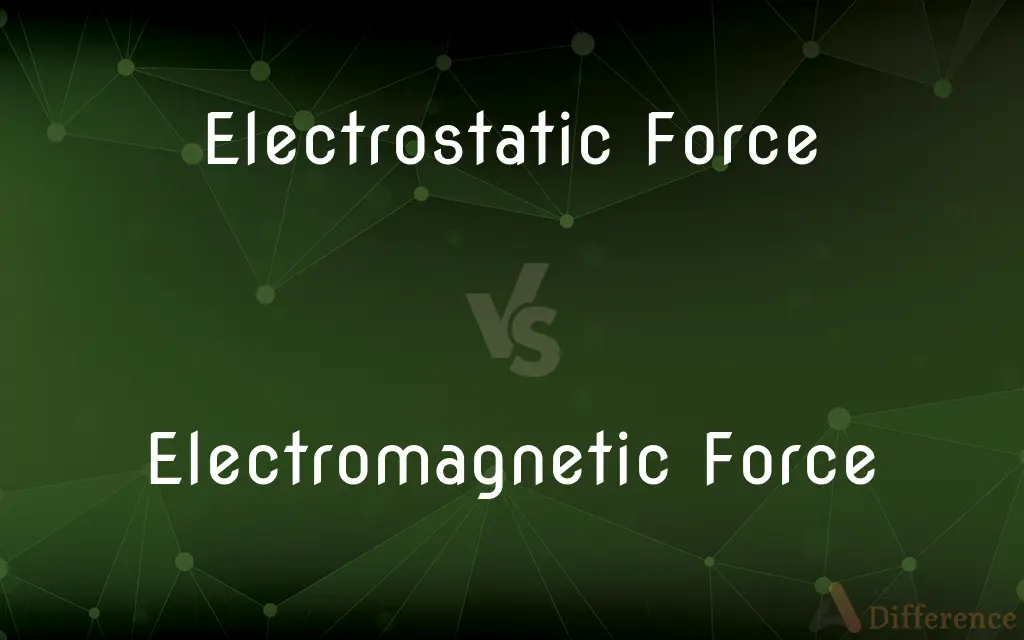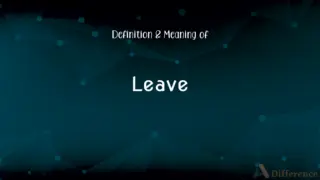Electrostatic Force vs. Electromagnetic Force — What's the Difference?
By Tayyaba Rehman — Published on December 20, 2023
Electrostatic force arises from stationary charges, while electromagnetic force involves both stationary and moving charges.

Difference Between Electrostatic Force and Electromagnetic Force
Table of Contents
ADVERTISEMENT
Key Differences
Electrostatic force is the force between stationary electric charges. When we talk about charged objects that are not moving, like a balloon rubbed on hair, we are discussing electrostatic forces. Electromagnetic force, on the other hand, encompasses not only the forces between stationary charges but also between moving charges. This broader category includes phenomena like light, radio waves, and microwaves.
Electrostatic force is crucial for understanding how objects become charged and interact when at rest. When we think about static shocks or how certain materials stick together, it's the electrostatic force at work. Electromagnetic force plays a more extensive role in the universe, affecting everything from the behavior of subatomic particles to the motion of galaxies, as it includes both electric and magnetic forces.
Electrostatic force is responsible for the attraction or repulsion between objects due to their charges, which are not moving. For instance, two like-charged objects repel each other. Electromagnetic force considers the dynamics when charges start moving, generating magnetic fields and resulting in phenomena like electromagnetic radiation.
Electrostatic force can be seen in everyday phenomena like dust sticking to a TV screen or hair standing up when rubbed with a balloon. Electromagnetic force is more pervasive, influencing the behavior of electric circuits, the functioning of our electronic devices, and even the nature of light itself.
Electrostatic force is a subset of the electromagnetic force, which is one of the four fundamental forces of nature. This distinction highlights the significance and broad range of phenomena governed by the electromagnetic force, while the electrostatic force focuses solely on stationary charges.
ADVERTISEMENT
Comparison Chart
Nature of Charges
Deals with stationary charges.
Covers both stationary and moving charges.
Range of Influence
Limited to nearby stationary charges.
Vast, influencing a range from subatomic to cosmic scales.
Associated Phenomena
Static electricity, static cling.
Light, radio waves, magnetic fields, etc.
Examples
Balloon sticking to a wall, hair standing on end.
Electromagnetic radiation, functioning of electronic devices.
Position among Fundamental Forces
Subset of electromagnetic force.
One of the four fundamental forces of nature.
Compare with Definitions
Electrostatic Force
A non-contact force emerging from static electric fields.
Lightning is a discharge resulting from the build-up of electrostatic force in clouds.
Electromagnetic Force
The force acting on charges, whether stationary or in motion.
Electromagnetic force is responsible for the current flowing in a wire.
Electrostatic Force
The attraction or repulsion due to electric charge at rest.
Electrostatic force causes hair to stand up when rubbed with a balloon.
Electromagnetic Force
A force that encompasses a wide range of phenomena from light to electricity.
Electromagnetic force ensures that electronic devices function properly.
Electrostatic Force
The force governing static electrical phenomena.
Electrostatic force can be demonstrated by bringing two charged objects close to each other.
Electromagnetic Force
A fundamental force associated with electric and magnetic fields.
The electromagnetic force between electrons and protons keeps atoms intact.
Electrostatic Force
The stationary counterpart of electromagnetic force.
While magnets can attract certain metals through electromagnetic forces, a charged comb can pick up paper through electrostatic force.
Electromagnetic Force
Governs interactions of charged particles and their associated fields.
The magnetic field around a current-carrying wire is due to the electromagnetic force.
Electrostatic Force
A force between stationary electric charges.
Two balloons with similar charges repel each other due to electrostatic force.
Electromagnetic Force
The broader category that includes electrostatic and magnetic forces.
Radio waves are a form of electromagnetic radiation, driven by electromagnetic force.
Common Curiosities
Is electrostatic force a type of electromagnetic force?
Yes, it's a subset, focusing specifically on stationary charges.
Can you give an everyday example of electrostatic force?
Sure, static cling or hair standing up when rubbed with a balloon.
What is the electrostatic force?
It's the force between stationary electric charges.
And what about the electromagnetic force?
It encompasses forces between both stationary and moving charges.
How does the electromagnetic force play a role in electronics?
It's the force that drives current in circuits and makes electronic devices work.
How are magnetic fields related to the electromagnetic force?
Moving charges generate magnetic fields due to the electromagnetic force.
Why do like charges repel due to electrostatic force?
It's a property of charges; similar charges repel, opposites attract.
What's the key difference between electrostatic and electromagnetic forces?
Electrostatic deals with stationary charges, while electromagnetic involves both stationary and moving charges.
Is the electromagnetic force only about electricity?
No, it also involves magnetic fields and encompasses phenomena like light.
Can you feel electrostatic force?
Yes, like when you get a static shock from touching a metal object.
Why is electromagnetic force considered fundamental?
It's one of the four primary forces governing the interactions in our universe.
Is gravity stronger than electromagnetic force?
No, the electromagnetic force is much stronger than gravity, but its effects often cancel out on large scales due to equal positive and negative charges.
How is lightning related to electrostatic force?
It's a discharge resulting from the build-up of electrostatic forces in clouds.
How does the electromagnetic force keep atoms together?
It's the force of attraction between the electrons and the nucleus.
Are electromagnetic waves a result of the electromagnetic force?
Yes, they're a manifestation of oscillating electric and magnetic fields.
Share Your Discovery

Previous Comparison
Mom Jeans vs. Skinny Jeans
Next Comparison
Stale Cheque vs. Post-Dated ChequeAuthor Spotlight
Written by
Tayyaba RehmanTayyaba Rehman is a distinguished writer, currently serving as a primary contributor to askdifference.com. As a researcher in semantics and etymology, Tayyaba's passion for the complexity of languages and their distinctions has found a perfect home on the platform. Tayyaba delves into the intricacies of language, distinguishing between commonly confused words and phrases, thereby providing clarity for readers worldwide.













































